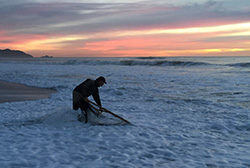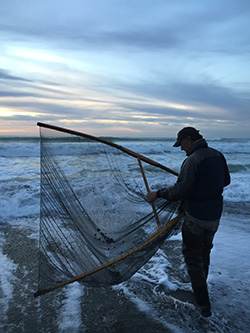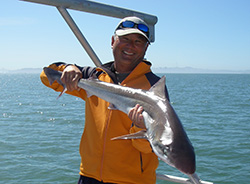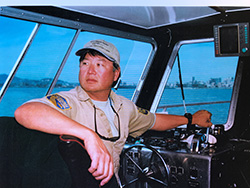
Fishing for night smelt from the beach in Pacifica.

Fishing for night smelt from the beach in Pacifica.

Ken Oda holds a soupfin shark caught while capturing California halibut for a hooking mortality study.

Ken Oda piloting the research vessel Triakis on San Francisco Bay while doing Pacific herring surveys.
Ken Oda is an environmental scientist with CDFW’s Marine Region and a member of the Northern and Central California Finfish Research and Management Project. Based out of the Monterey office, Ken is also the lead person for sandy beach surfperch research and management.
Where did you grow up?
I was born and raised in Monterey. My great-grandfather operated a sardine cannery on Cannery Row, and my grandfather ran a wholesale fish business on Wharf 1 in Monterey, specializing in local abalone.
What led you to a career in marine biology?
It’s genetics. My mom’s family was in the commercial fishing industry. My dad was an avid fisherman and diver. I became fishing-obsessed at a young age and wanted to learn everything I could find about fish. Given my strong interest in fish and all things fishing, my parents “suggested” that I choose a career path consistent with my fish fascination.
After searching for colleges offering fisheries degrees, I decided that Humboldt State University could offer me the best education. I graduated from Humboldt State with a Bachelor of Science degree in fisheries, with a mariculture emphasis.
In 1982, my mom went to the annual open house at the CDFW’s Granite Canyon Mariculture Laboratory in Big Sur. She had a conversation with the director, Earl Ebert, who invited me to do my senior thesis at the lab as a volunteer student intern. My job entailed taking care of juvenile Red Abalone. Later, my first paying position was as a scientific aid sampling sport and commercial rockfish landings from Monterey to Santa Cruz. I worked as a fisheries technician on groundfish for the Pacific States Marine Fisheries Commission. By 1988, I began my first permanent position as an entry level marine biologist. Later I promoted to marine biologist conducting population assessments on San Francisco Bay herring. In 2005, I transferred back to Monterey, which eventually landed me on my current project.
What inspires you?
The learning opportunities. I remember reading vintage issues of CDFW journals and informational publications, e.g., ocean fishing maps and fish identification books, and thought that I’d want to do that kind of work someday. I had the privilege to meet and work with ichthyologists Dan Miller, Dan Gotshall and Bob Lea, who authored the publications that I had read.
I’m also inspired by the fact that I’m working on surfperch fisheries that my family have been active participants in since the 1910s.
What is a typical day like for you at work?
The best thing about my job is having daily opportunities to learn something new while in the field, interacting with others or through data analysis.
I’m doing more writing than fieldwork these days, but on those days when I can get out of the office, I head to a local beach to collect surfperch. To do so, I gather up my fly and/or conventional rods and reels, a tackle bag/soft cooler, electronic thermometer, and a smart phone for taking photos and storing data in the field. If successful, I’ll bring the fish back to the lab and collect life history information from them: lengths, weights, sex, maturity, and ear bones (otoliths) used for age determination and input the data into a spreadsheet.
When I’m not in the field, I check and respond to emails and phone calls, and search for publications to support the reports that I’m writing.
What interesting projects are you working on currently?
Writing “Enhanced Status Reports” (ESRs) as part of the implementation of the 2018 Marine Life Management Act Master Plan for Fisheries. The ESRs describe the individual species or species groups, habitat, research and management, and the state-managed fisheries that they support.
What accomplishment are you most proud of?
I was the project lead person that coordinated the purchasing process for building a custom research boat for the Pacific Herring Project. This was the first for the Marine Region in many years. The process from the funding proposal to delivery of the boat took about three years. It took a team of CDFW staff, consultations with commercial fishermen, boat builders and naval architects and engineers to pull it together and deliver a boat that is still in service after 20 years.
Over the course of your career, was there a discovery or an incident that surprised you?
During the 1997 El Niño storms when levees in the Delta broke and caused widespread flooding, it was not unusual to see random items drifting around in San Francisco Bay while doing surveys — a travel trailer, dead cattle, snakes, a refrigerator.
What are the best – and most challenging – things about being a fish and wildlife scientist?
I appreciate feeling “dialed in” with the fish species through field work and seeing fish in the flesh. Fish and fishermen are more than numbers in a table or points in a graph and observations sometimes can’t be captured on paper or camera.
The most challenging aspect is presenting information that you know won’t be popular to a group of people and trying to remember that you’ve done your best despite their reactions.
If you had free reign and unlimited funding, what scientific project would you most like to do?
A statewide quantitative survey of surf species using fishing rod castable armored cameras and a fleet of four-wheeled ATVs.
Away from work, where are we likely to find you?
Fishing somewhere — on a tropical flat, a coastal river for steelhead, or the Delta for striped bass. I’m happy fishing anywhere for just about anything.
Tell us something about yourself that many people would be surprised to learn.
I played competitive volleyball, which resulted in two surgeries and broken fingers.
Do you have any advice for people considering careers in science or natural resources?
Realize that it’s a very competitive field these days for jobs, prepare accordingly, take opportunities to meet those working in the field that have taken similar career paths and volunteer to determine if a job/career is what you really want. Keep an open mind — we never know it all.
CDFW Photos courtesy of Ken Oda. Top Photo: Ken Oda at work collecting surfperch in his Sandy Beach Surfperch Research and Management project.